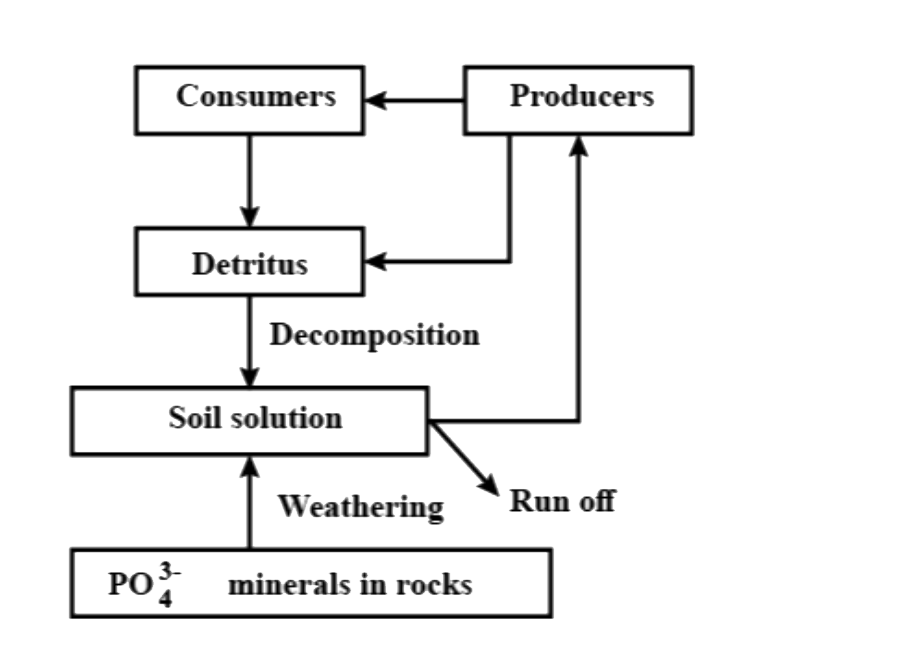One of the useful activities of several bacteria is
(a) Nitrification
(b) Biogeochemical cycles
(c) Nitrogen fixation
(d) Sulphurification
Nitrification
Biogeochemical cycles
Nitrogen fixation
Sulphurification.
The correct Answer is:B
To solve the question regarding the useful activities of several bacteria, we will analyze each option provided:
1. Understanding the Question: The question asks for one of the useful activities of several bacteria. We need to identify which of the given options is primarily associated with beneficial functions performed by bacteria.
2. Analyzing Each Option:
- (a) Nitrification: This process involves the conversion of ammonia into nitrites and then into nitrates. While important, nitrification is dependent on the initial process of nitrogen fixation. Therefore, it is not the primary useful activity of bacteria.
- (b) Biogeochemical cycles: These cycles involve the movement of chemical elements and compounds between living organisms and the environment. While bacteria play a role in these cycles, their contribution is often not as significant as the primary processes they perform, such as nitrogen fixation.
- (c) Nitrogen fixation: This is the process by which certain bacteria convert atmospheric nitrogen (N₂) into ammonia (NH₃) or related compounds. This is a crucial process for the ecosystem, as it allows nitrogen to be utilized by plants, making it the most significant and useful activity of bacteria.
- (d) Sulphurification: This process involves the conversion of sulfate into sulfide, which is also important, but it is not as widely recognized as nitrogen fixation in terms of its usefulness to the ecosystem.
3. Conclusion: After analyzing all the options, we determine that the most useful activity of several bacteria is (c) Nitrogen fixation.
Final Answer:
(c) Nitrogen fixation
- (a) Nitrification: This process involves the conversion of ammonia into nitrites and then into nitrates. While important, nitrification is dependent on the initial process of nitrogen fixation. Therefore, it is not the primary useful activity of bacteria.
- (b) Biogeochemical cycles: These cycles involve the movement of chemical elements and compounds between living organisms and the environment. While bacteria play a role in these cycles, their contribution is often not as significant as the primary processes they perform, such as nitrogen fixation.
- (c) Nitrogen fixation: This is the process by which certain bacteria convert atmospheric nitrogen (N₂) into ammonia (NH₃) or related compounds. This is a crucial process for the ecosystem, as it allows nitrogen to be utilized by plants, making it the most significant and useful activity of bacteria.
- (d) Sulphurification: This process involves the conversion of sulfate into sulfide, which is also important, but it is not as widely recognized as nitrogen fixation in terms of its usefulness to the ecosystem.
(c) Nitrogen fixation
Topper's Solved these Questions
- KINGDOM MONERA (THE PROKARYOTES)BOOK - DINESH PUBLICATION ENGLISHCHAPTER - KINGDOM MONERA (THE PROKARYOTES)EXERCISE - CHECK YOUR GRASP
20 Videos
- KINGDOM MONERA (THE PROKARYOTES)BOOK - DINESH PUBLICATION ENGLISHCHAPTER - KINGDOM MONERA (THE PROKARYOTES)EXERCISE - CHECK YOUR GRASP
20 Videos
- KINGDOM FUNGI-MULTICELLULAR DECOMPOSERSBOOK - DINESH PUBLICATION ENGLISHCHAPTER - KINGDOM FUNGI-MULTICELLULAR DECOMPOSERSEXERCISE - CYG
19 Videos
- KINGDOM PLANTAE OR METAPHYTA BOOK - DINESH PUBLICATION ENGLISHCHAPTER - KINGDOM PLANTAE OR METAPHYTA EXERCISE - CYG
20 Videos
Similar Questions
Knowledge Check
Bacteria are :
(a) free-living organisms
(b) parasites
(c) nitrogen-fixers
(d) all of theseAfree-living organismsBparasitesCnitrogen-fixersDall of theseEnterokinase activates
(a) pepsin
(b) trypsin
(c) chymotrypsin
(d) trypsinogenApepsinBtrypsinCchymotrypsinDtrypsinogen
Chain of rod shaped bacteria is
(a) Streptococcus
(b) Streptobacillus
(c) Staphylococcus
(d) Staphylobacillus
View SolutionThe diagram/flow chart represents which of the sedimentary biogeochemical cycle ?

(a) Nitrogen cycle
(b) Phosphorus cycle
(c) Oxygen cycle
(d) Sulphur cycle
View SolutionBacteria which directly convert atmospheric nitrogen into nitrogen compounds are called
(a) Nitrogen fixing bacteria
(b) Nitrifying bacteria
(c) Putrefying bacteria
(d) Denitrifying bacteria
View SolutionMark the incorrect option (w.r.t. nitrifying bacteria)
(a) Nitrococcus
(b) Leptothrix
(c) Nitrobacter
(d) Nitrocystis
View SolutionThe main function of elementary bodies in Mycoplasma / some primitive bacteria is
(a) Reproduction
(b) Respiration
(c) Secretion
(d) Food storage
View SolutionPutrefying bacteria are found in
(a) Intestine
(b) Stomach
(c) Liver
(d) Colon
View Solution
